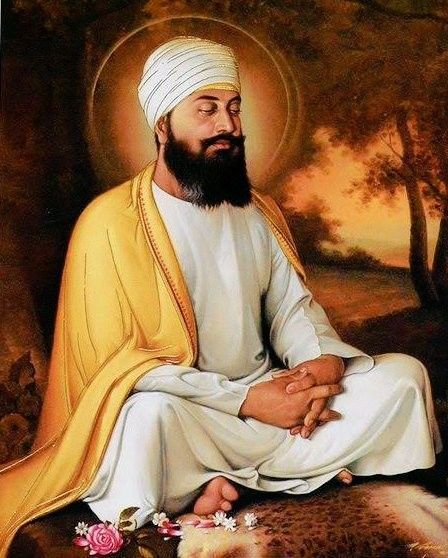
Guru Teg Bahadur was admired and worshipped as the ninth Sikh Guru and is celebrated for his dedication to justice, human rights, and religious freedom. His life story and martyrdom have left an unforgettable mark on Sikhism and Indian history. The significance of Guru Teg Bahadur goes beyond his role as a spiritual leader; he stood firmly for righteousness, which earned him the title of "Hind di Chadar" or "Shield of India." His sacrifice is observed every year on Guru Tegh Bahadur Shaheedi Diwas, which is commemorated on November 24th , remembering his ultimate stand against oppression.
Guru Tegh Bahadur Shaheedi Diwas 2024
Guru Tegh Bahadur Shaheedi Diwas 2024, also known as Guru Tegh Bahadur Martyrdom Day, will be observed on Sunday, November 24, 2024. On this day in 1675, Guru Tegh Bahadur was executed by the Mughal Emperor Aurangzeb in Delhi for refusing to convert to Islam and for standing up for the rights of Hindus to practice their religion freely. The day is commemorated by Sikhs worldwide with prayers, hymns, and other religious ceremonies. In Gurudwaras, special kirtans and prayers are held to honor Guru Tegh Bahadur's selfless act. Devotees remember his legacy of courage, integrity, and sacrifice, reflecting on his teachings of compassion, humility, and the protection of the oppressed.| Shaheedi Diwas 2024 | |
| Event | Details |
| Occasion | Shaheedi Diwas 2024 |
| Date of Observance | November 24, 2024 |
| Significance | Commemoration of the martyrdom of Guru Teg Bahadur |
| Observed by | Sikhs and admirers of Guru Teg Bahadur globally |
| Key Activities | Prayer gatherings, kirtans (hymn singing), and community service |
| Primary Message | Honouring Guru Teg Bahadur's stand for justice, human rights, and religious freedom |
Who Was Guru Tegh Bahadur?
Guru Teg Bahadur was born in Amritsar on April 1, 1621, to Guru Hargobind, the sixth Sikh Guru, and Mata Nanaki. Bahadur was named Tyaga Mal at birth and he grew up with the influence of the rich spiritual and warrior traditions of Sikhism. His father ‘Guru Hargobind’ was instrumental in introducing the concept of "Miri Piri" (temporal and spiritual power) in Sikhism , a core principle that Guru Teg Bahadur would later manifest. His early life was memorized by strict training in both spiritual and martial arts, preparing him for the challenges he would face as a spiritual leader.

He became the ninth Sikh Guru in 1664 after the demise of Guru Har Krishan , the eighth Sikh Guru. Upon his ascension, he was renamed "Tegh Bahadur," which means "Brave Sword," a reflection of his commitment to both protection and compassion.
Guru Tegh Bahadur Biography and Early Life
Guru Teg Bahadur's life was dedicated to service, meditation, and the pursuit of justice. As a young man, he was known for his peaceful and thoughtful nature while spending years in prayer and meditation. Not like previous Sikh Gurus, who generally remained in Punjab, Guru Teg Bahadur travelled extensively across the Indian subcontinent, while often visiting the regions as far as Assam and Bihar, to spread the teachings of Sikhism. These journeys allowed him to connect with people of diverse backgrounds which solidified the universal values of Sikhism.
During his travels, Guru Teg Bahadur emphasized the importance of compassion, tolerance, and selflessness. He also composed 115 hymns, which are included in the Guru Granth Sahib . His teachings were based on inner detachment, truthful living, and the futility of worldly attachments, all while supporting a disciplined spiritual life.
| Guru Teg Bahadur Biography | |
| Attribute | Details |
| Full Name | Guru Tegh Bahadur |
| Birth | April 1, 1621, in Amritsar, Punjab |
| Parents | Guru Hargobind (father) and Mata Nanaki (mother) |
| Designation | Ninth Sikh Guru |
| Known For |
|
| Key Contributions |
|
| Martyrdom | November 24, 1675, in Chandni Chowk, Delhi |
| Legacy | Symbol of courage, protector of religious rights, celebrated annually on Shaheedi Diwas |
9th Sikh Guru and His Contribution to Sikhism
As the ninth Sikh Guru, Guru Teg Bahadur continued the work of his predecessors, while ensuring Sikhism’s teachings of equality, justice, and compassion remained vibrant and impactful.
- He supported the protection of the oppressed and preached against the forced religious conversion and persecution prevalent under Mughal rule. His efforts strengthen the Sikh community’s motive to stand up against any form of injustice, regardless of the perpetrator's power.
- One of Guru Teg Bahadur's most significant contributions was the establishment of the city of Anandpur Sahib in Punjab, which became an important spiritual center for Sikhs. This sacred city remains a focal point of Sikh pilgrimage and heritage.
- Anandpur Sahib symbolized unity and strength for the Sikh community while operating as a place where people gathered to learn, worship, and prepare themselves to defend the faith if needed.
The Martyrdom of Guru Teg Bahadur
Guru Teg Bahadur's martyrdom is a defining moment in Sikh history and is commemorated every year as Shaheedi Diwas on 24th November. The story of his sacrifice begins with the rule of Mughal Emperor Aurangzeb, who aspired to impose Islamic law across his empire, particularly targeting Hindus and Sikhs for religious conversion.
- When a group of Kashmiri Pandits approached Guru Teg Bahadur for help in 1675, he willingly accepted the challenge to stand up against the forced conversions.
- To confront Aurangzeb’s oppressive policies, Guru Teg Bahadur travelled to Delhi, even before knowing well the risks involved. His message to the emperor was clear: “Religious freedom is a fundamental right, and individuals must have the liberty to practice their faith without fear . ”
- Refusing to accept Islam and convert his religion, Guru Teg Bahadur suffered brutal torture, yet he remained steady and resolute in his beliefs.
- Ultimately Aurangzeb gave up, and he was executed in Delhi’s Chandni Chowk on November 24, 1675. His martyrdom symbolizes a universal stand for human dignity and freedom of conscience, regardless of religious or cultural identity.
Legacy and Influence of the Ninth Sikh Guru
The legacy of Guru Teg Bahadur deeply influenced Sikh culture and Indian history. His teachings on compassion, resilience, and faith have continued to inspire Sikhs and people around the world. His compositions in the Guru Granth Sahib showcase his profound spirituality and act as a guide for Sikh followers on leading a life of purpose and principle.
In addition to his spiritual teachings, Guru Teg Bahadur’s legacy lives on through places such as Gurudwara Sis Ganj Sahib, built in Chandni Chowk, Delhi, at the exact location of his martyrdom. It functions as a reminder of his courageous stand and the high price he paid to defend religious freedom.
Guru Teg Bahadur's martyrdom also set an example that would influence the Sikh community’s future. It taught the Sikhs that while they must be compassionate and just, they must also be prepared to protect those values with unwavering resolve.
List of Sikh Gurus and Their Contributions
Guru Teg Bahadur’s place as the ninth Sikh Guru comes within a lineage of ten Gurus who each contributed uniquely to Sikhism. Here is a brief list of Sikh Gurus and their contributions:
- Guru Nanak Dev – Founder of Sikhism, who preached equality and the unity of humanity.
- Guru Angad Dev – Developed the Gurmukhi script and encouraged physical activity.
- Guru Amar Das – Advocated for social reforms, including the abolishment of caste discrimination.
- Guru Ram Das – Founded the city of Amritsar, a major Sikh spiritual center.
- Guru Arjan Dev – Compiled the Adi Granth, the precursor to the Guru Granth Sahib, and built the Golden Temple.
- Guru Hargobind – Introduced the concept of Miri Piri, integrating temporal and spiritual authority.
- Guru Har Rai – Promoted the expansion of Sikhism through education and compassion.
- Guru Har Krishan – Known as the “Child Guru,” remembered for his service to the poor and sick.
- Guru Teg Bahadur – Advocated for religious freedom and sacrificed his life for human rights.
- Guru Gobind Singh – Established the Khalsa, formalized the Sikh identity, and declared the Guru Granth Sahib as the eternal Guru.
Conclusion
Guru Teg Bahadur’s life and martyrdom resonate as a profound statement of courage, compassion, and commitment to justice. As the ninth Sikh Guru, he stood as a pillar of strength for the Sikh community and a protector for all who faced religious persecution. His legacy continues to inspire millions globally, and his teachings remain a vital part of Sikhism. On Shaheedi Diwas 2024 , Sikhs and admirers worldwide pay tribute to his sacrifice, honouring the timeless values of freedom, resilience, and unity he upheld.
Ready to take the next step in your UPSC journey? Enroll in our comprehensive course today!
| UPSC Related Articles | ||
| UPSC Prelims Questions | NCERT for UPSC Exam 2025 | UPSC Mains Admit Card |
| UPSC Mains Exam Pattern | UPSC Scholarship Test | UPSC Result |
<span style=
What is Guru Teg Bahadur ji known for?
Who was Guru Tegh Bahadur?
Who was the 9th Sikh Guru?
Why did Aurangzeb execute Guru Teg Bahadur?
Who took Guru Teg Bahadur Ji's head to Anandpur Sahib?
Where is Guru Teg Bahadur Ji’s martyrdom remembered?
Who founded Anandpur Sahib?







